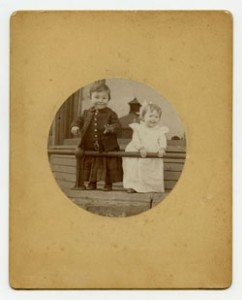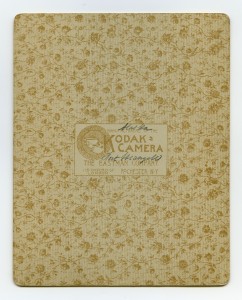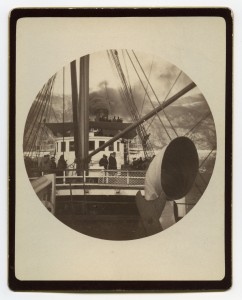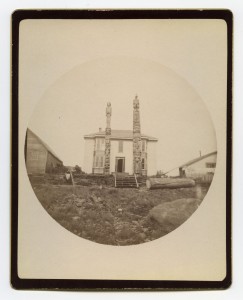This was the question I got recently as I was sorting through some photographic material at my desk and was putting carefully aside a small, round photograph of two children.  As you might already know, the American Antiquarian Society has important holdings of early photography, including daguerreotypes from the 1830s and cabinet photographs of performers from the 1870s. A description of the entire photography collection and links to many illustrated inventories of our photographic holdings are available via our website. But today, in order to mark an important anniversary in photographic history, I wanted to post about a handful of small, round, images in our collection that date from well after 1876, our usual cut-off date for collecting.
As you might already know, the American Antiquarian Society has important holdings of early photography, including daguerreotypes from the 1830s and cabinet photographs of performers from the 1870s. A description of the entire photography collection and links to many illustrated inventories of our photographic holdings are available via our website. But today, in order to mark an important anniversary in photographic history, I wanted to post about a handful of small, round, images in our collection that date from well after 1876, our usual cut-off date for collecting.
On April 6, 1889, George Eastman sold his very first Kodak Camera No. 1, a single lens, bulky, wooden contraption that used rolled film. The No. 1 was a camera designed for the people, not for professional photographers. Perhaps this doesn’t sound like such a big deal today, when I can snap a photograph with my cell phone and email it half way around the world in a second or two. But until 1889 the populace could only consume photographs produced by professional photographers. You had to haul yourself and your family to the photographer’s studio to get a family portrait.  Or you hired the professional photographer in town to come out and take a picture of your home or your prize cow, or your factory or business. AAS has thousands of wonderful photographs that were produced by commercial photographers including the bulk of the portrait photographs in the collection, our 60,000 stereo photographs, and the majority of our views of cities and towns from across the United States.
Or you hired the professional photographer in town to come out and take a picture of your home or your prize cow, or your factory or business. AAS has thousands of wonderful photographs that were produced by commercial photographers including the bulk of the portrait photographs in the collection, our 60,000 stereo photographs, and the majority of our views of cities and towns from across the United States.
Eastman’s invention of the No. 1 revolutionized photography. Patented in 1888, but not sold until the following spring, the camera, at $10, allowed almost anyone who could afford the price to create a visual record of their lives, outside of the professional photographer’s studio. The exposures were a distinctive round shape and can be identified both by this shape and by their mounts, which are usually marked with the Kodak insignia. The camera had severe limitations (it could only take 100 shots, had to be returned to Kodak for processing, and had a finicky shutter that was set with a string), but it was successful enough that the company quickly come out with a smaller, more affordable version, the Kodak No. 2, or Brownie camera, which was released later in 1889.

Because of the late dates, AAS does not hold many images taken with the early Kodaks, but I am including three in this post for your enjoyment. The charming photograph at the top of this post is of Gladys (age 1) and George Gage (age 2), c. 1888. It was the recent gift of Ingrid E. Wade and came to the Society in an album of family photographs.This image is one of the last in the album and is the only one not taken by a professional photographer (the relaxed postures and smiling faces on the toddlers are a dead give away that Mom or Dad are probably behind the lens). The two other images are later in date and were probably taken with a Brownie. These images, by an unknown tourist, were taken during a journey to Sitka, Alaska, in 1897 and are part of a set of about a dozen images found in the Society’s holdings of Alaskan views.

Not impressed? Well, consider this – how many times in your life have you sat for a commercial photographer? Well, for most of us there are all those dreadful elementary school pictures, the senior prom, and at our weddings perhaps. Maybe a military shot, or an official head shot for business. These are a small percentage of the images we now have of our lives. In 2010, almost every photographic image of our family, our travels, our home, our celebrations, we take ourselves. We post them on Facebook and we email them to distant relatives. We make digital albums where we can flip them, fade them, spin them upside down, if we want. All of this control over our images, every little pixel, owes its existence to Eastman and his Kodak No. 1. He really did bring photography to the masses, starting with little, round prints like these.

This article needs some correction, I’m afraid:
Eastman’s “The Kodak” camera was advertised and introduced in late-summer, 1888. It cost $25, not $10. The camera was not referred to as the “#1 Kodak” until the “#2 Kodak” came out in 1889. #1 and #2 referred to film and image size, not order of appearance in the Eastman lineup. The #2 Kodak was not cheaper…it cost $40 vs. the #1 at $25. These cameras were never called “Brownie” cameras. The first Kodak “Brownie Camera” came out in summer of 1900 and cost $1.
Paul, Thank you for your comments! Because AAS does not normally collect material from this era, I appreciate your input. There are many resources available on the web that cover the start of Kodak and their early cameras, starting with the corporate site for the company (http://www.kodak.com/global/en/corp/historyOfKodak/historyIntro.jhtml?pq-path=2217/2687). Brian Coe’s 1988 book Kodak Cameras: the first hundred years might also prove helpful.
May I ask Paul, who seems to know his way around all the early Kodak cameras’ dates of introduction as well as prices, what the Kodak Bull’s Eye No. 2 (1895) or the Kodak Bull’s Eye No. 2 Special cost in 1899? German expressionist painter Gabriele Münter (1877-1962) was given one of these (I don’t know which) during an extended visit with her American relatives in Missouri and Texas in 1898/99. She soon became a very adept photographer, and the photographic gaze she developed would have a great influence on her painting.